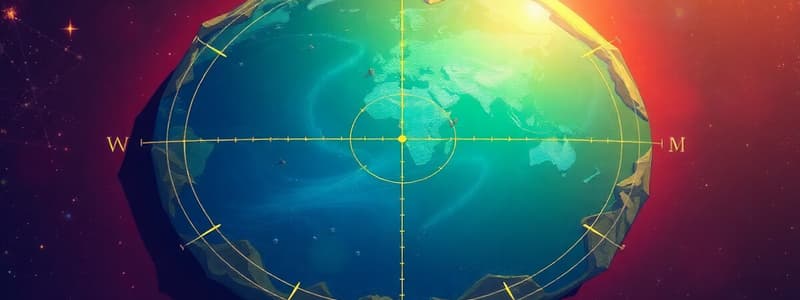Podcast
Questions and Answers
What represents the polar angle in spherical coordinates?
What represents the polar angle in spherical coordinates?
- φ
- θ (correct)
- P
- ρ
Which of the following statements is true about lines of latitude?
Which of the following statements is true about lines of latitude?
- They indicate angular distance north or south of the Equator. (correct)
- They are constant in distance from each other.
- They are referred to as meridians.
- They can exceed 90 degrees.
What is represented by the coordinates (0,0,0) in spherical coordinates?
What is represented by the coordinates (0,0,0) in spherical coordinates?
- The azimuthal angle
- The polar angle
- The origin (correct)
- The radial distance
In a parallel projection, how is the center of projection typically positioned?
In a parallel projection, how is the center of projection typically positioned?
Which of the following angles is also known as the azimuthal angle in spherical coordinates?
Which of the following angles is also known as the azimuthal angle in spherical coordinates?
What does the angular distance of a point east or west of the Prime Meridian refer to?
What does the angular distance of a point east or west of the Prime Meridian refer to?
What property of a map projection ensures that the shape of geographical features is accurately represented?
What property of a map projection ensures that the shape of geographical features is accurately represented?
Which type of projection preserves equal area across the map?
Which type of projection preserves equal area across the map?
Which type of projection has the center of projection at a finite distance from the projection plane?
Which type of projection has the center of projection at a finite distance from the projection plane?
For an azimuthal projection, which aspect occurs when the tangent plane is positioned at one of the poles?
For an azimuthal projection, which aspect occurs when the tangent plane is positioned at one of the poles?
What is the term used for lines that run parallel to the Equator?
What is the term used for lines that run parallel to the Equator?
In a conical projection, what is the term for the line where the cone intersects the globe and is error-free?
In a conical projection, what is the term for the line where the cone intersects the globe and is error-free?
What happens in a secant cylindrical projection compared to a tangent cylindrical projection?
What happens in a secant cylindrical projection compared to a tangent cylindrical projection?
What is the perspective point in an orthographic projection?
What is the perspective point in an orthographic projection?
Which aspect of azimuthal projections allows for the preservation of true direction?
Which aspect of azimuthal projections allows for the preservation of true direction?
What defines a tangent conical projection in terms of its interaction with the globe?
What defines a tangent conical projection in terms of its interaction with the globe?
Which datum is considered a global datum?
Which datum is considered a global datum?
What is the primary reason for the diversity of datums across different geographical regions?
What is the primary reason for the diversity of datums across different geographical regions?
Which spheroid is used in North America for NAD27?
Which spheroid is used in North America for NAD27?
The flattening of the Earth can be expressed by the formula?
The flattening of the Earth can be expressed by the formula?
What does the eccentricity (e²) of an ellipse indicate?
What does the eccentricity (e²) of an ellipse indicate?
Which of the following is NOT a characteristic of a best-fit ellipsoid?
Which of the following is NOT a characteristic of a best-fit ellipsoid?
What does the term 'oblate spheroid' refer to?
What does the term 'oblate spheroid' refer to?
Which relationship describes eccentricity in relation to flattening?
Which relationship describes eccentricity in relation to flattening?
What defines a geocentric ellipsoid?
What defines a geocentric ellipsoid?
What is the primary purpose of creating a map?
What is the primary purpose of creating a map?
Which of the following is NOT typically considered an element of a map?
Which of the following is NOT typically considered an element of a map?
Which aspect is emphasized by cartographers when designing maps?
Which aspect is emphasized by cartographers when designing maps?
What is a critical evaluation criterion for successful maps?
What is a critical evaluation criterion for successful maps?
What is referred to as cartography?
What is referred to as cartography?
Which of the following statements is true about map representation?
Which of the following statements is true about map representation?
What does the term 'scale' refer to in map design?
What does the term 'scale' refer to in map design?
Which type of map is specifically designed for accurate measurements?
Which type of map is specifically designed for accurate measurements?
What do qualitative thematic maps primarily display?
What do qualitative thematic maps primarily display?
Which of the following is NOT considered a type of thematic map?
Which of the following is NOT considered a type of thematic map?
What is the main purpose of General Reference Maps?
What is the main purpose of General Reference Maps?
Topographical maps represent elevation through which of the following?
Topographical maps represent elevation through which of the following?
Which type of map would be most suitable for someone interested in political districts?
Which type of map would be most suitable for someone interested in political districts?
Cadastral Maps are primarily used for what purpose?
Cadastral Maps are primarily used for what purpose?
Which of the following is a characteristic of General Reference Maps?
Which of the following is a characteristic of General Reference Maps?
Flashcards
Latitude
Latitude
Angular distance north or south of the Equator.
Longitude
Longitude
Angular distance east or west of the Prime Meridian.
Radial Distance (ρ)
Radial Distance (ρ)
Distance from the origin in a spherical coordinate system.
Polar Angle (θ)
Polar Angle (θ)
Signup and view all the flashcards
Azimuthal Angle (φ)
Azimuthal Angle (φ)
Signup and view all the flashcards
Perspective Geometrical Projection
Perspective Geometrical Projection
Signup and view all the flashcards
Non-Perspective Geometrical Projection
Non-Perspective Geometrical Projection
Signup and view all the flashcards
Conformality
Conformality
Signup and view all the flashcards
Equivalence
Equivalence
Signup and view all the flashcards
Equidistance
Equidistance
Signup and view all the flashcards
Azimuthal direction
Azimuthal direction
Signup and view all the flashcards
Polar Azimuthal Projection
Polar Azimuthal Projection
Signup and view all the flashcards
Equatorial Azimuthal Projection
Equatorial Azimuthal Projection
Signup and view all the flashcards
Gnomonic Projection
Gnomonic Projection
Signup and view all the flashcards
Orthographic Projection
Orthographic Projection
Signup and view all the flashcards
Conical Projection
Conical Projection
Signup and view all the flashcards
Cylindrical Projection
Cylindrical Projection
Signup and view all the flashcards
Datum
Datum
Signup and view all the flashcards
Local Datums
Local Datums
Signup and view all the flashcards
WGS84
WGS84
Signup and view all the flashcards
Spheroids and Ellipsoids
Spheroids and Ellipsoids
Signup and view all the flashcards
Cartography
Cartography
Signup and view all the flashcards
Purpose of Maps
Purpose of Maps
Signup and view all the flashcards
General Reference Maps
General Reference Maps
Signup and view all the flashcards
Thematic Maps
Thematic Maps
Signup and view all the flashcards
Cartometric Maps
Cartometric Maps
Signup and view all the flashcards
Topographical Maps
Topographical Maps
Signup and view all the flashcards
Study Notes
Geographic Coordinate System
- North Pole: latitude 90° N; South Pole: latitude 90° S.
- Latitude measures angular distance north or south of the Equator in degrees, minutes, and seconds.
- Lines of latitude are called parallels.
- Longitude measures angular distance east or west of the Prime Meridian (Greenwich) in degrees, minutes, and seconds.
- Lines of longitude are referred to as meridians.
Spherical Coordinate System
- Describes a point using three numbers: radial distance (ρ), polar angle (θ), azimuthal angle (φ).
- ρ represents the distance from the origin; the coordinates of the origin are (0, 0, 0).
- θ is the angle between the x-axis and the projection of the point on the xy-plane.
- φ is the angle between the line to the point and the positive z-axis.
Projection of the Earth
- 3-D Earth can be represented in 2-D through two main projection types:
- Perspective Geometrical Projection: Center is at a finite distance.
- Non-Perspective Geometrical Projection (Parallel Projection): Center is at an infinite distance; projectors are parallel.
- An ideal map should preserve four properties: conformality, equivalence, equidistance, azimuthal direction.
- Example projections include Lambert conformal conic and Albers equal-area conic.
Azimuthal Projections
- Can be centered on poles (polar), equatorial (at any point on the equator), or oblique (at any other orientation).
- Light source can vary, affecting perspective: gnomonic (light at the center), orthographic (light at infinity), stereographic (light at a specific Earth point).
Conical Projections
- Achieved by intersecting a cone with the globe; a tangent cone forms a circle of error-free mapping.
- Secant cones can produce two circles with equidistance, slicing under the Earth's surface.
Cylindrical Projections
- Created by touching a cylinder to the globe's surface, then unrolling it.
- Tangent cylinders intersect at the equator; secant cylinders have two equidistant lines.
Datums
- Defines size and shape of the Earth; critical for accuracy in mapping and GPS.
- Local datums include European, Australian Geodetic, Tokyo, Indian, and North American Datum 1983 (NAD83).
- WGS84 serves as a global datum.
Spheroids and Ellipsoids
- Define shape for map projections; characterized by axes lengths and eccentricity.
- Clarke 1866 and GRS 1980 are spheroids used in North America.
- Earth is modeled as an oblate spheroid due to rotational flattening, with flattening factor (f) and eccentricity (e²) used for calculations.
Introduction to Maps
- Maps depict all/part of Earth’s surface at a reduced scale; cartography is the art/science of map-making.
- Maps highlight spatial relationships and provide a visual representation of areas.
Purpose of Maps
- To visualize larger areas not easily seen.
- Show unseen phenomena or processes.
- Present information concisely.
Cartographer Considerations
- How curved surfaces are represented on flat maps (projection).
- Maps simplify reality and selectively depict information (scale).
- Importance of symbolization and aggregation for effective communication.
Common Map Elements
- Data frame, map legend, title, north arrow, scale bar, metadata, border, inset map.
Evaluation Criteria for Maps
- Maps should meet user needs, be user-friendly, accurate, clear, and visually appealing.
- Ideally, they permit user interaction for updates and personalization.
Types of Maps
- General Reference Maps: Display natural and man-made features for public use, like road maps.
- Thematic Maps: Highlight specific data or features, which can be qualitative (categories) or quantitative (numerical data).
- Cartometric Maps: Designed for accurate measurements; used in navigation and resource management.
- Topographical Maps: Show elevation through contour lines (connecting points of equal height above sea level).
Studying That Suits You
Use AI to generate personalized quizzes and flashcards to suit your learning preferences.




